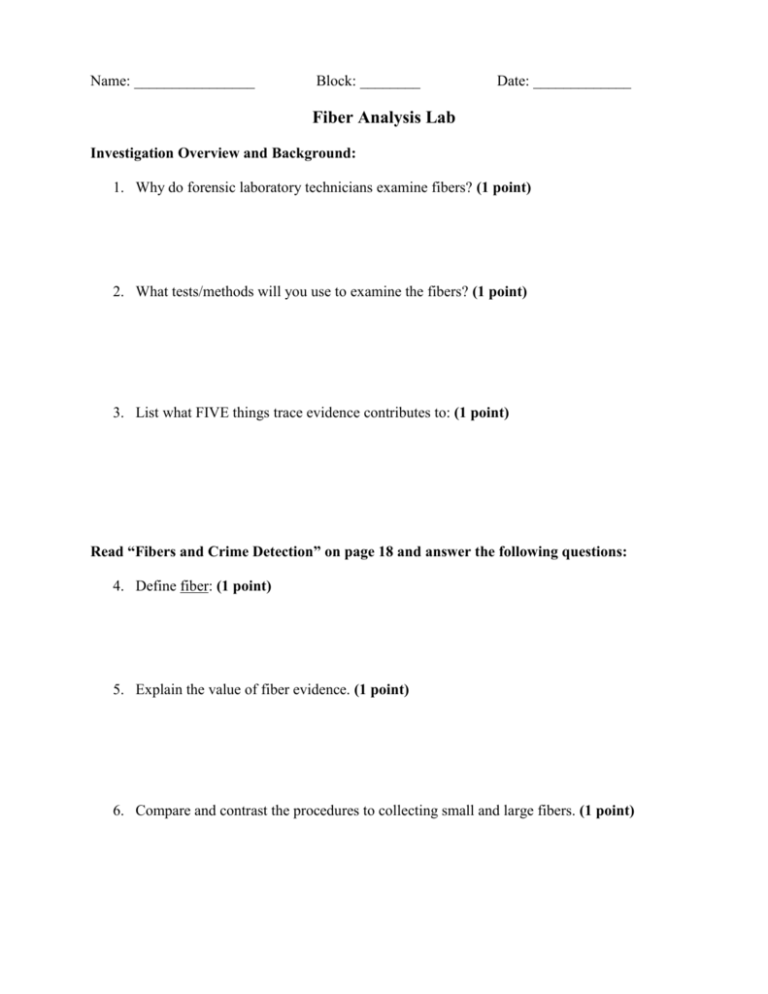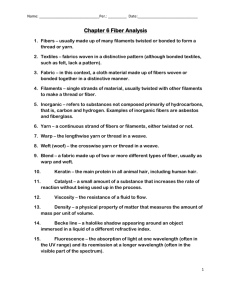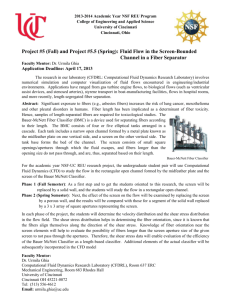Name
advertisement

Name: ________________ Block: ________ Date: _____________ Fiber Analysis Lab Investigation Overview and Background: 1. Why do forensic laboratory technicians examine fibers? (1 point) 2. What tests/methods will you use to examine the fibers? (1 point) 3. List what FIVE things trace evidence contributes to: (1 point) Read “Fibers and Crime Detection” on page 18 and answer the following questions: 4. Define fiber: (1 point) 5. Explain the value of fiber evidence. (1 point) 6. Compare and contrast the procedures to collecting small and large fibers. (1 point) Procedure: Part A: The Physical Properties of Fibers 1. Read Step 3 a-e of the procedure (pg. 19). This describes the physical properties tests that you will perform. 2. Once you have read the procedure, draw a data table on a separate sheet of paper. Use Table 1 (pg. 19) for reference. 3. Complete the physical properties test and record the data in the data table. Be as specific as possible. You will need this data at a later date. 4. Next, read steps 4-5 of the procedure. In these steps you will be creating a wet mount slide of your fiber samples and examining them under a microscope. Prepared slides of fiber samples will also be provided for you to examine. 5. Sketch each sample that you view on your data table. Be sure to label each with the fiber type as well as magnification under which it was viewed (magnification = objective lens x ocular lens). Before moving on to Part B, ask yourself these questions: Did I examine each fiber for physical properties? Is my data table completely filled out for each fiber sample I tested? Are my descriptions of each fiber sample clear and specific? Did I draw what each fiber looked like under low magnification? Did I report the magnification? Part B: The Chemical Properties of Fibers 1. Read step 1 of the procedure and create a data chart (describe on page 22) for the chemical properties tests on a separate sheet of paper. 2. Once you have created a data table, complete steps 2-10 (you should already have fiber samples). Before moving on to Part B, ask yourself these questions: Did I examine each fiber for chemical properties? Were my descriptions of each test described as specified in the procedure? Did I test each sample for pH? Part C: Unknown 1. 2. 3. 4. Obtain an unknown fiber sample. Record any data on a separate sheet of paper. Complete the physical properties tests for the unknown. Complete the chemical properties tests for the unknown. Identify the unknown fiber sample. Before moving on to the Analysis/Conclusion questions, ask yourself these questions: Did I test the unknown fiber for physical properties? Did I test the unknown fiber for chemical properties? Did I properly identify the unknown fiber? Analysis/Conclusion: 1. Identify the unknown fiber sample. What physical/chemical properties support this answer? (2 points) 2. Natural fibers (ex. cotton, flax/linen, wool, silk) and synthetic fibers (ex. nylon, Orlon, Dacron, polyester, Lycra, Spandex, rayon) were examined in this lab. Were there noticeable differences between natural and synthetic fibers in your physical/chemical test results? Describe these differences. (2 points) Physical Chemical 3. Which physical/chemical test results were most useful in identifying the unknown sample? (1 point) Physical Chemical 4. Were the identifications you made for the unknown in Part A consistent with the unknown in Part B? (1 point) 5. Do forensic technicians need to do both physical and chemical tests to identify fibers? Explain your answer using evidence from the previous question. (2 points) Lab Checklist: Before you turn in your lab, make sure you have completed the following: _____ Completed Investigation Overview and Background Questions _____ Completed “Fibers and Crime Detection” Questions _____ Completed Data Table for Part A _____ Completed Data Table for Part B _____ Completed Analysis/Conclusion Questions Score: _____ / 3 Investigation Overview and Background Questions _____ / 3 Completed “Fibers and Crime Detection” Questions _____ / 3 Completed Data Table for Part A _____ / 3Completed Data Table for Part B _____ / 8 Completed Analysis/Conclusion Questions _____ / 20 Total Comments:







